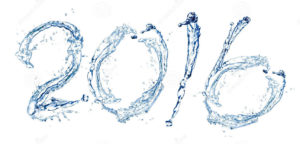
Found on google.com
10-13-2016: Updated to include Los Angeles Bureau of Sanitation
We have just begun a new water year, which means now is a good time to close the books on 2016 and talk about it. Lets analyze fill station activity and ask “how much recycled water did <agency name> produce in the 2016 water year?”
As we have learned from the recent State Water Resource Control Board water conservation numbers, California residents are not continuing to conserve as much despite the fact that we’re now heading into a 6th year of drought. When homeowners are faced with mandatory water conservation requirements, people will do the right thing (conserve), but when rules changed to voluntary participation, so did their water usage behavior.
Last week, the State Water Resources Control Board announced that, compared to 2013 numbers, urban water conservation dropped from 27 percent in August 2015 to 17.7 percent this past August. It’s a clear sign that voluntary reduction targets aren’t having the same effect as the 25 percent statewide mandatory cuts issued by Gov. Jerry Brown a year and half ago, which were lifted in June. – Michael Levitin @ Water Deeply
This fact is further pressed into stone when we look at fill station activity year over year and find that for some agencies, activity is down nearly 30%, but for most, especially those in southern California, the opposite is true.
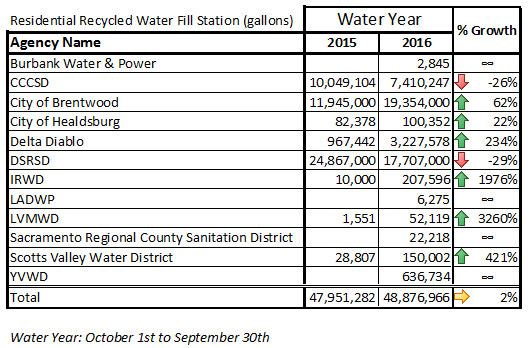
Year over year RRWFS volume given away.
Dublin San Ramon Services District
One example of where residential recycled water fill station activity has decreased is at Dublin San Ramon Services District (DSRSD) in Pleasanton, California. During the 2015 water year, DSRSD gave away 24,867,000 gallons of recycled water, where as this year, 7 million less gallons were hauled away bringing about a 29% reduction to 17,707,000 gallons. This reduction in activity can be seen in the following chart. Note: Complete data was shared by DSRSD this month to provide a more accurate representation.
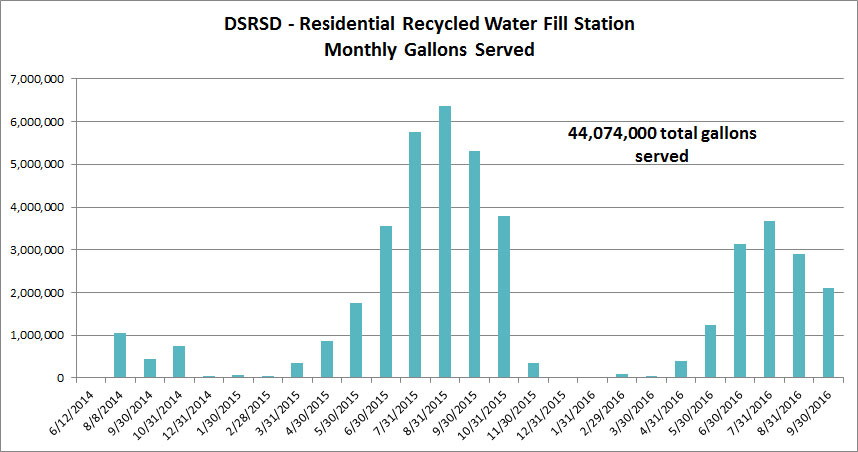
44,074,000 gallons recycled water given away since June 2014.
At the peak in August 2015, more than 6,000,000 gallons of recycled water was hauled away by fill station customers (3400 registered users at the time). July 2016 was the top month this year where a little more than 3.6 million gallons were taken home, a reduction of 40%, and the number of registered users over these 11 months rose by nearly 500 people. By the end of September, 3,957 registered users took home 2,097,000 gallons of recycled water bringing total volume hauled away since June 12, 2014 to 44,074,000 gallons.
If we look at total recycled water production, 1,196,173,000 gallons (1.196 Billion gallons or 3,670.92 acre feet). Enough water to supply 3670 homes with water for a year. This is also about the volume of Pacoima Reservoir on Pacoima Creek in the San Gabriel Mountains in Los Angeles County, California.
Upon closer inspection of the data provided, during the summer months, DSRSD produces over 7 million gallons of recycled water a day and in winter months, those numbers fall to around 360,000 gallons per day. This water is used for landscape irrigation.
Las Virgenes Municipal Water District
In Southern California, where the drought never ended, activity at fill stations are up, where each month agencies are giving away more recycled water than in the previous month. An example of this is at Las Virgenes Municipal Water District (LVMWD), in Calabasas.
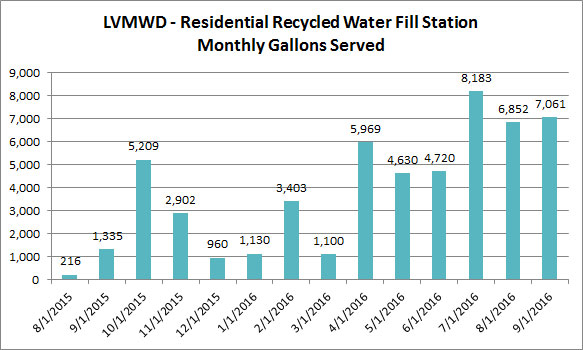
Month over month, volume given away trends upwards.
Last month, LVMWD gave away 7,061 gallons bringing their total volume up to 53,670 gallons since the fill station first opened in August 2015. The fill station also had 8 new users sign up, bringing their total registered users up to 91.
We did ask for 2016 Water Year information in regards to total recycled water production, that data was unavailable. Last year, 2.09 Billion gallons (6,413.9 acre-feet) of recycled water was created. This is approximately the volume of Lyons Reservoir, a hydroelectric dam owned and operated by PG&E in Tuolumne County. By the numbers from the agencies that reported their stats at the time of publishing, was the largest volume produced.
For LVMWD, these 2.09 Billion gallons accounts for 20% of the water usage in their service district. Every gallon of recycled water re-used is a gallon of potable water saved. The water is used for “irrigating golf courses, parks, school grounds, highway landscapes and common areas of certain housing developments.”
Delta Diablo
Delta Diablo, as we’ve written about many times before, annually provides over 2 Billion gallons of recycled water for industrial, municipal, commercial and residential use in East Contra Costa county. In their case, Delta Diablo supplies cooling water for two large natural gas fired power plants, so there is a continuous daily demand for recycled water.
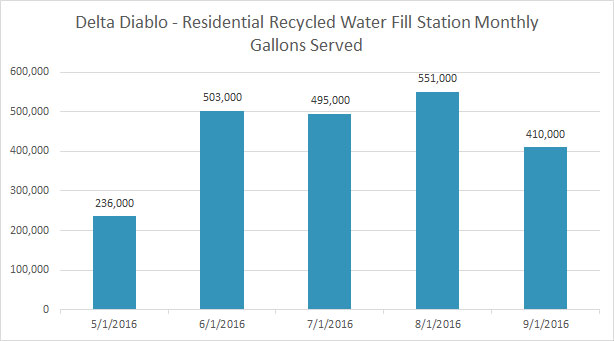
* Delta Diablo annually provides over 2 Billion gallons of recycled water for industrial, municipal, commercial and residential use in East Contra Costa.
Last month, 15 new customers signed up to haul away recycled water. This brings their total user base to 495 registered users. They also hauled home 410,000 gallons, bringing their total volume hauled since July 11th, 2015 to 4,195,000 gallons.
Fill station activity has shown to increase tremendously, going from 967,000 gallons during the 2015 water year to over 3,227,000 gallons during the 2016 water year. This increase in participation at the residential recycled water fill station accounts for 0.16% of Delta Diablo’s recycled water portfolio. The emphasis to remember here is 90% of the recycled water produced is used to cool a power plant, which saves drinking water supplies for sustaining human life.
Scotts Valley Water District
The Scotts Valley Water District created “63,645,903 gallons of recycled water (195.32 acre feet) over the previous water year from October 1, 2015 through September 30th, 2016″ wrote Eileen Eisner-Streller recently in an email to me. “The fill station gave away 156,711 gallons during the same period.” This volume from the recycled water fill station accounts for 0.25% of Scotts Valley Water District’s recycled water portfolio.
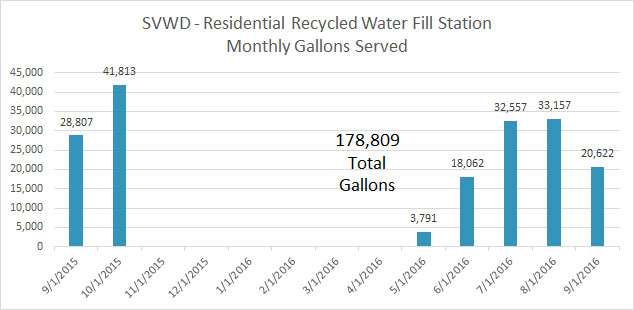
Last month, 20,622 gallons were served to 89 registered users (one new user signed up to haul away free recycled water). While the fill station was more active this summer, large monthly volumes are down compared to this time last year, more water was hauled away this summer as the fill station opened during the middle of last summers hauling season (August 2015).
City of Healdsburg
In Northern California’s wine country, the City of Healdsburg “created 358.4 million gallons (1,099.89 acre feet) of recycled water. Of that recycled water distributed among various customers/uses, approximately 100,000 was from the recycled water fill station which accounted for 0.028% of total recycled water usage,” wrote Water/Wastewater Operations Superintendent Rob Scates.
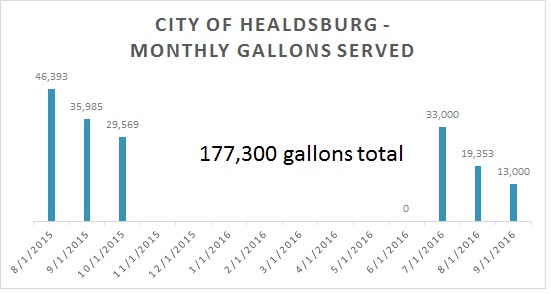
Building on information supplied to RecycledH2O.net last year, the City of Healdsburg installed a “PortALogic automated fill station during the summer of 2016 to assist with customer/volume recordkeeping.” This has enabled the “fill station to remain open for the fall season,” and periodically close around rain events.
“The City will continue to provide recycled water to residents during upcoming years as needs dictate.” Great news!
City of Brentwood
The City of Brentwood sits on the edge of the California Delta and is required to treat their entire flow to Title 22 unrestricted reuse standards. Last water year, that meant 1,202,080,000 gallons (3,689,05 acre feet) of wastewater was turned into recycled water. 172 Million gallons was recycled City-wide. Of this 172 Million gallons, 19 Million was distributed to residents via the Recycled Water Fill Station. The remaining 1.028 Billion gallons of recycled water was discharged to Marsh Creek.
Let that set in for a moment.
1.6% of all recycled water produced by the treatment plant was hauled away in 300 gallon totes, sitting in the back of pick up trucks or on trailers. The rest, flowed to the ocean, was pulled out of the delta for drinking water or was used by the wildlife that depend on it for their survival.
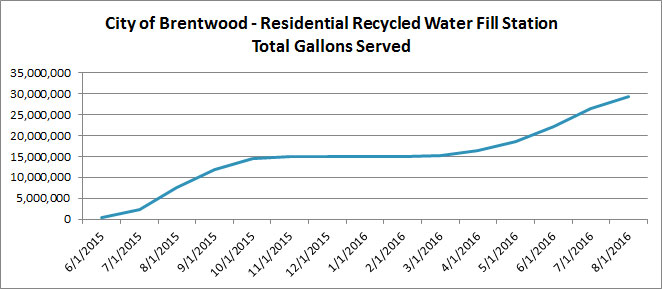
Last month, users of the fill station hauled away 2,013,000 gallons to bring their total since the program stated in June 2015 to 31,300,000 gallons of recycled water.
City of Redwood City
The City of Redwood City used and distributed to irrigation and industrial customers, 319,559,812 gallons (980.7 acre feet) of recycled water, which was provided by Silicon Valley Clean Water, the data is from July 2015 until August 2016. Not quite complete, but a great building point for further investigation next year.
Latest data available from the mobile recycled water fill station shows no new users signed up for the program, 591,557 gallons were hauled home which accounts for just 0.18% of total recycled water use within the city.
Los Angeles Bureau of Sanitation
In the 2015-2016 fiscal year (July 2015 to June 2016), the Los Angeles Bureau of Sanitation treated 114,373,701,000 gallons (351,000 Acre-Feet) of wastewater at the City’s four water reclamation plants (WRP).
- Two WRPs (Donald C. Tillman & Los Angeles-Glendale) produced approximately 16,618,401,000 gallons (51,000 Acre-Feet) of tertiary treated recycled water.
- The Terminal Island WRP produced 5,539,467,000 gallons (17,000 Acre-Feet) of tertiary and advanced treated recycled water.
- Approximately 12,936,284,700 gallons (39,700 Acre-Feet) was delivered from the Hyperion WRP to West Basin Municipal Water District for additional treatment to offset potable demand within the City of LA and regionally.
About 8,797,977,000 gallons (27,000 Acre-Feet) is used for environmental enhancement recreational projects. The Los Angeles Department of Water and Power reported an offset of 3,230,160,963 gallons (9,913 Acre-Feet) of potable water for the year.
All data for this section was provided by Ellen Cheng, spokesperson for LADWP.
Burbank Water and Power
The Burbank Water Reclamation Plant (BWRP) produced 1,105,400,000 gallons (3,392.35 acre feet) of recycled water from October 1st, 2015 to September 30th, 2016.
Final thoughts:
Updated: Including the data from the Los Angeles Bureau of Sanitation, our original posts number of 6.2 Billion gallons (25,579.97 Acre-Feet) jumps up to 43.4 Billion gallons (133,280.97 Acre-Feet) of recycled water was created during the 2016 water year. This inclusion, weighs heavily on the fact that of the agencies that responded to data requests, the total volume of recycled water created from Northern California accounts for about 13% of the volume of recycled water created in Southern California.
| Region | Volume Recycled Water Produced (acre feet) |
| Northern California * | 15,774 |
| Southern California * | 117,506 |
To compare this volume of water to a reservoir (133,281 acre feet) in California, were split between Lake Perris in Riverside county (131,452 acre feet) and Shaver Lake in Fresno County (135,283 acre feet). Data Source: https://en.wikipedia.org/wiki/List_of_dams_and_reservoirs_in_California
This accounts for just a partial sampling of many agencies around California that create recycled water from wastewater. If there is anything that should be taken away from this, all energy production facilities – such as power plants and oil refineries should be using recycled water instead of drinking water for non-potable things. Remember, a gallon of recycled water produced is a gallon of drinking water saved.
*Not every agency that creates recycled water was asked for their data, the focus was on agencies that operate a Residential Recycled Water Fill Station. Then, even still, every agency didn’t respond to requests for information.



Leave a Reply